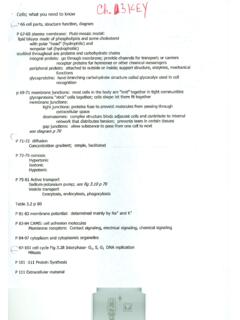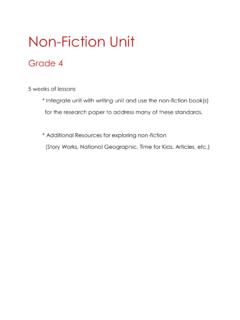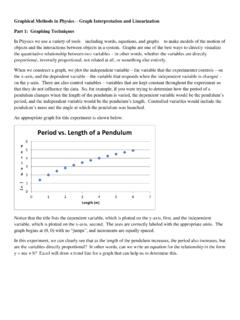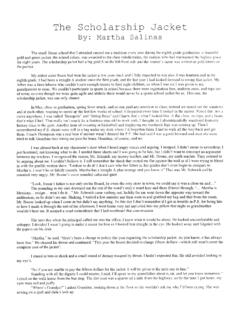Transcription of NONFICTION THIRST I - wtps.org
1 MAY 2016 54 SCHOLASTIC SCOPE MAY 2016 MORRIS WEINTRAUB/COURTESY OF CHARITY: WATER (POURING WATER); COURTESY OF CHARITY: WATER (NATALIA)It was still night in Mozambique, a country in southeast Africa. But for 13-year-old Natalia, this dark hour was the start of her day. She dragged herself out of bed a thin straw mat and dressed quietly. Her three younger sisters were still sleeping in the room they all shared. Natalia slipped out of their hut and set off into the darkness. THIRSTNARRATIVE NONFICTION reads like fiction but it s all trueShaking off sleep, Natalia moved briskly. It was 4:30 , and there was not one second to waste. She was beginning a grueling journey, one that would take hours. She would walk about a mile in the dark through fields of tall grasses where snakes lurked. But she walked without fear. She had been making this trip two times a day, seven days a week, since she was 10 years old. Why?She was not heading to school, or to a job, or to visit a was going to fetch the water her family needed to survive.
2 Nataliaa water-starved village, and the simple well that of a teenage girl, changed it incredible true story BY KRISTIN LEWIS, WITH TYLER MAY 2016 76 SCHOLASTIC SCOPE MAY 2016think about this dream on her trips to get water. The chore often took hours. First there was the walk. Then there was the hours-long wait in line at one of three shallow holes dug into the dried-up streambed where villagers gathered their water. When it was Natalia s turn, she would fill up a plastic jerry can with about 3 to 5 gallons of water. Filled, a small jerry can weighs about 20 pounds. The larger ones can weigh up to 40 pounds. That is about the same weight as three backpacks stuffed with books. Imagine lugging those three backpacks for one mile. Now imagine doing it twice a day, every day. Without complaint. The water that Natalia brought home was gray and dirty. Natalia s family boiled their water before drinking it, but some dangerous bacteria survived the high heat.
3 The water often made Natalia and her brothers and sisters sick. There was no other choice, though. The muddy streambed was the only source of water for many miles around. Water-related illness is a major problem in developing countries like Mozambique. According to the World Health Organization, million people die every year from water-related illnesses. On Their OwnWhat Natalia s village really needed was a well. A deep well would tap into an aquifer underground rocks that hold water, like a sponge. Water from the aquifer would be purer and cleaner than the water from the streambed; it would not be contaminated by animals or human waste. That s because sediment in the soil can act as a natural filter, trapping harmful bacteria and a well would give the villagers water that was safe to drink. It would also set Natalia and other girls free. Unburdened from the arduous chore of water gathering, Natalia would be able to go to school. But digging a well requires expensive machines and scientific expertise neither of which Natalia s village could MCMAHON/MAPMAN (MAP); COURTESY OF CHARITY: WATER (DRILL); ESTHER HAVENS/COURTESY OF CHARITY: WATER (TRUCKS)No Other ChoiceNatalia is a serious girl, soft-spoken but not shy.
4 From a young age, she loved learning but the burden of getting water for her family left time for little else, including her own education. Most weeks, she was lucky to make it to school one or maybe two days. She d managed to learn to read and write, but she dreamed of doing far more, like one day running her own had plenty of time to LYNN JOHNSON/NATIONAL GEOGRAPHIC CREATIVEA LuxuryFor most of us in the United States, getting clean water is as simple as turning on the faucet. You probably don t think twice about taking a long, refreshing shower after soccer practice. You mindlessly brush your teeth maybe you even leave the water running before bed each night. You have water fights with your friends on hot summer days. The average American uses 176 gallons of water a day. That s enough to fill about 1,900 soda cans. But for more than 660 million people around the world, even one sip of clean water is a luxury. In Natalia s village, for example, nobody has water that flows from a tap or flushes in a toilet or gushes from a backyard hose.
5 Toilets are pits in the ground. Bathing is done with jugs of water. And every drop of water is precious. Until recently, it was up to the women and children of the village, particularly girls like Natalia to spend many hours each day fetching water for their families. What role does water play in people s lives? AS YOU READ, THINK ABOUT:WATER TECHNOLOGYThe nonprofit organization charity: water sponsors water projects all over the world. In this project in Ethiopia, special drills dig deep holes that tap into underground water. Other kinds of technology can also be used to bring clean, safe water to places that need it. Pipes can carry water down from nearby mountains. Rainwater from roofs can be collected and JOURNEY FOR WATER Getting clean water is a challenge in many parts of the world. In this image from Ethiopia, girls and boys carry river water to use for drinking and cooking. The trip takes them two to three hours, and they often make it several times a day.
6 Of mapEQUATORAFRICAMOZAMBIQUEC onstruction crews sponsored by charity: water in MAY 2016 98 SCHOLASTIC SCOPE MAY 2016 Into Her HandsThen, in 2014, an incredible organization called charity: water heard about Natalia s village and wanted to help. The organization But it meant everything. For the first time in Natalia s life, clean, fresh water poured into her hands. Water Is LifeHumans have always told stories about water legends and folktales of magical fountains that give eternal youth and miracle springs that cure sickness. In one Norse myth, the god Odin gives up one of his eyes to drink from a sacred well said to grant divine wisdom. These are just stories, of course, but there is truth behind them: Water is life. Every now and then, something will happen in the that reminds us how essential water is to our way of life. In 2014, a chemical spill turned water in West Virginia a toxic yellow. More recently, decaying pipes poisoned the tap water in Flint, Michigan, with lead.
7 Natalia will never need to be reminded that water is a gift that it should never be taken for granted. It s been nearly two years since those trucks rolled into her village. Villagers are rarely sick. They can bathe whenever they want. And they never go s life has been transformed. Instead of spending her day fetching water, she goes to school. She is a top student, with plans to run her own school and improve the lives of other girls through education. And she has taken on a new project. The village elected Natalia to be president of its new water committee. Her intelligence and confidence made her perfect for the job. Now, instead of hauling water is a nonprofit that has funded nearly 20,000 water projects throughout the world, including more than 200 in Mozambique. Charity: water partnered up with a local humanitarian organization called World Vision Mozambique. And in August 2014, the two groups sent large trucks rolling into Natalia s on her back every day, she oversees a team of five adults.
8 The team is in charge of watching over the well. They keep it in good condition. They protect it from animals, collect money for future repairs, and educate their neighbors about sanitation and hygiene. Her duties as president keep her busy, but it s important work that she is proud still walks briskly, but she no longer has to walk to the stream in the dark each morning. Now, her steps are taking her toward the future she always dreamed of. Scope would like to thank charity: water for generously partnering with us on this article. village. The workers surveyed the area, looking for the best place for a well. Once they found it, the workers started drilling. A thundering sound echoed throughout the village. Natalia and her neighbors came to watch the spectacle. Then the workers covered the hole and put a hand pump on top. It was not much to look at, just a simple pump protruding from the WEINTRAUB/COURTESY OF CHARITY: WATERJEREMY SNELL/COURTESY OF CHARITY: WATER (TYLER RIEWER); COURTESY OF CHARITY: WATER (WELL)How can something as simple as a well transform a person s life?
9 Answer this question in a short essay. Support your ideas with text evidence. Send your essay to NATALIA CONTEST. Five winners will get a copy of A Girl Named Disaster by Nancy Farmer. Scope will also make a donation to charity: water in the winner s name. WRITING CONTESTGET THIS ACTIVITY ONLINEMEET TYLER RIEWER FROM CHARITY: WATER Tyler Riewer, who helped report this story, works for charity: water, a nonprofit organization dedicated to bringing clean and safe drinking water to communities like Natalia s. As part of his job, Riewer travels to charity: water s project sites and writes about the people he meets. In the photo above, a boy in Mali helps Riewer get to shelter moments before a sandstorm hits. The photo at left shows the well that was built in Natalia s village. BACK TO SCHOOL Natalia (above right) in a classroom at her school.










